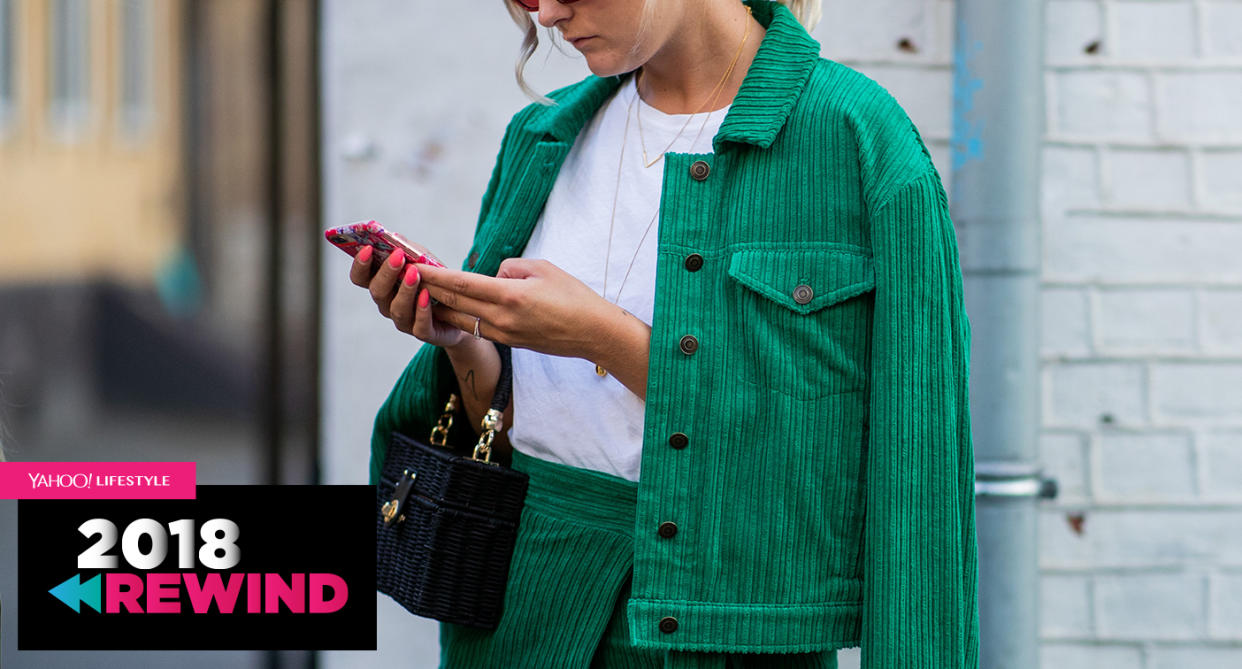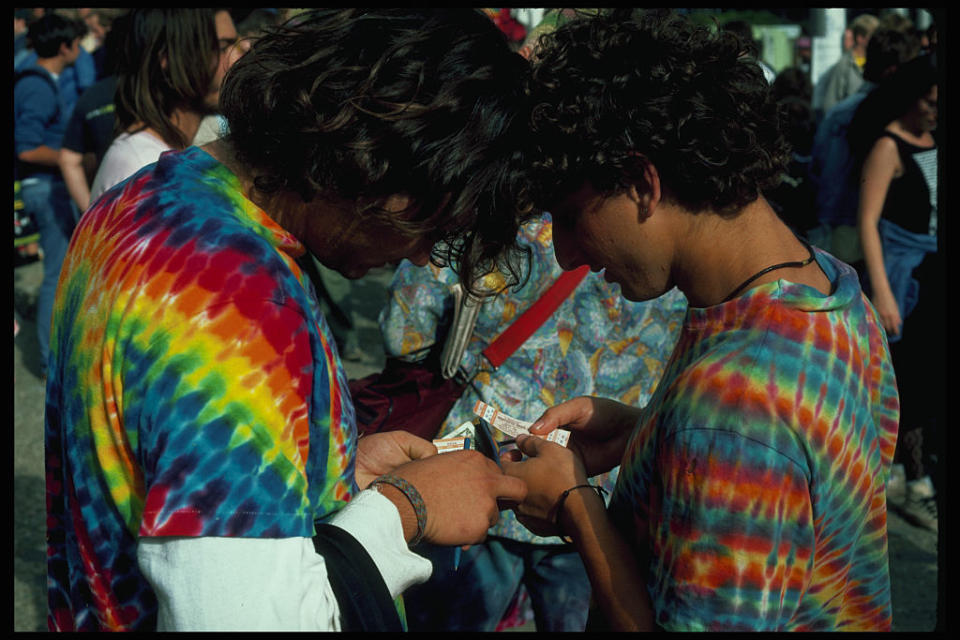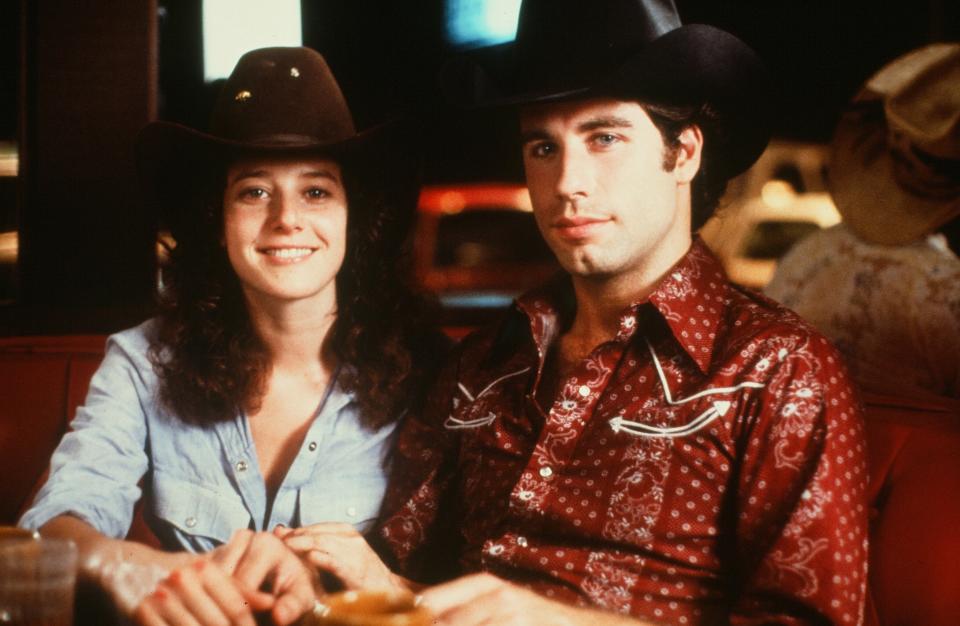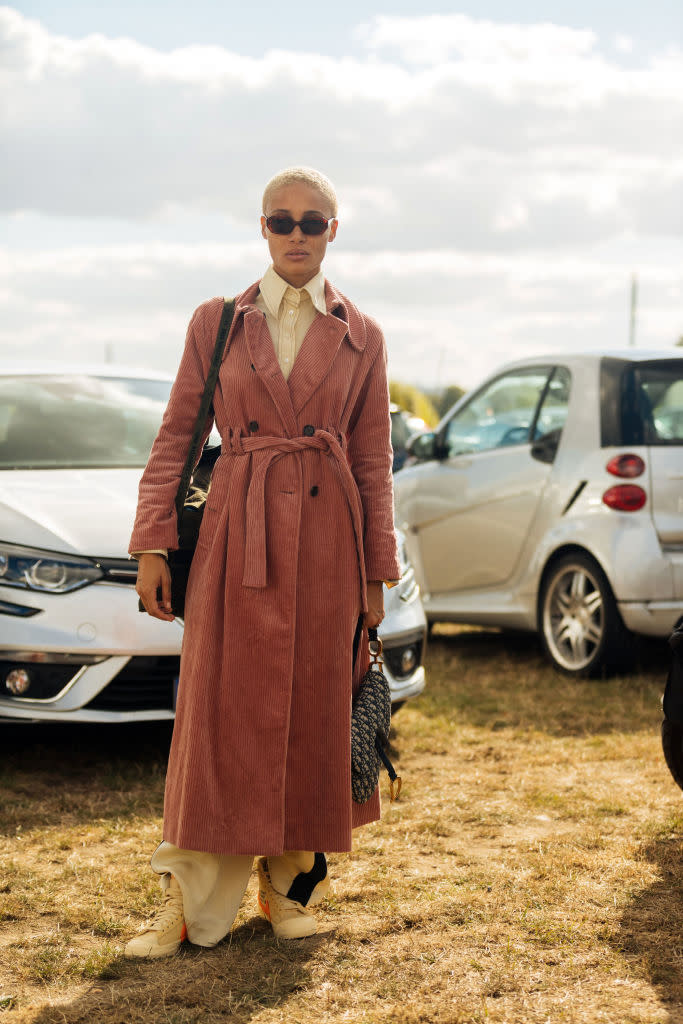From fanny packs to corduroy: The history behind the top 6 fashion trends of 2018

As 2018 comes to a close, it’s a good time to reflect on the fashion trends that have dominated catwalks and, subsequently, our closets over the past year. From accessorizing with hands-free fanny packs to tailoring your look with yoked and pearl-button-trimmed shirts (pairing nicely with obsessive Westworld watching), some of the year’s biggest trends have fascinating, often surprising histories that go back much further than the last decade or two.
Whether it’s a European skier essential or an ancient Egyptian textile, the origins of this year’s go-to pieces offer lots to learn and ponder. Ahead, the engrossing backstories of six key trends of 2018.
Before sliding into 2019, Yahoo Lifestyle takes a quick look back at some of the year’s biggest stories, and what’s happened since, with Rewind 2018.

Fanny packs
The pint-size purse, slung across the waist, has come a long way in recent years, with glitzy versions cropping up everywhere — from Gucci and Balenciaga to fast-fashion go-tos like Zara, all a far cry from the slightly dowdy staple of frumpy tourists everywhere. The fanny pack (known across the pond as a bum bag, because “fanny” is off-color British slang for vagina) gets its name from the way the belted bag hangs on the hips, above the butt, aka “fanny.”
The bag’s roots are a bit murky: The prevailing tale is that an Australian woman, Melba Stone, invented it in 1962, with kangaroo pouches as the possible inspiration. However, a 1954 Sports Illustrated gift guide (yes, those existed more than six decades ago) apparently included a leather fanny pack intended for athletic types, including cross-country skiers, cyclists, hikers and equestrians. In the ’70s, the fanny pack gained popularity with European skiers as a highly practical way to haul a lunch while hitting the slopes.

The item’s most recent trendy heyday was in the 1980s, following the ’90s, when they were used by ravers as a prime spot for stowing drugs at EDM festivals; they popped up again in the mid- to late aughts as ironic sorority gear, emblazoned with Greek letters and worn strictly to concerts, tailgaters and ’80s theme parties.
But the advent of the fanny pack came way before the late 20th century, with origins that can be traced to an elaborately detailed, waistband-slung bag dubbed a chatelaine, which is believed to date back to the Middle Ages and was popular in 15th-century France, as well as Edwardian and Victorian eras in Britain, circa the late 1800s to early 1900s. Another iteration of the fanny pack in the 19th century: Native Americans’ buffalo pouches, worn on the waist to stash essentials while hunting and gathering.
There are a slew of other, often whimsical global terms for the fanny pack: It’s dubbed a belly bag in Germany, a banana bag in France, Gee Bags in Ireland and a kidney bag in Spain, and in Italy it’s referred to as a marsupio (as in marsupial mammals, like kangaroos). Whether the trend is utterly silly or unexpectedly chic, its practicality factor is tough to deny.
Shop the fanny packs trend:
Gucci GG Marmont Matelassé Leather Belt Bag, $1,150
Zara Envelope-Shaped Fanny Pack, $26
Zara Animal Print Belt With Plate Detail, $40
Alexander Wang Attica Belt Bag, $650
Urban Outfitters Nylon Belt Bag, $19 (was $29)

Tiny sunglasses
Ultra-small-lensed sunnies, just barely covering the eyes with UV protection, have become a celebrity-adored must-have, sported by everyone from Kim Kardashian and the Hadid sisters to Selena Gomez. The resurgence of the ’90s shades staple over the past year or two can be credited to a couple of folks, including Kanye West, who apparently emailed Kardashian, forbidding her to don oversize shades.
“He sent me, like, millions of ’90s photos with tiny little glasses like this,” she says in a January 2018 episode of Keeping Up With the Kardashians. Designer Adam Selman, who counts Rihanna as a loyal fan, also helped the tiny sunglasses redux take off via his 2016 collaboration with Australian sunglasses brand Le Specs, specifically with the ultra-slim the Last Lolita style, worn by a wide array of stylish stars, including Kendall Jenner and Zo? Kravitz. Other designers that have hopped on the teensy-specs bandwagon include Gucci (creative director Alessandro Michele began incorporating them into collections as early as 2016), Balenciaga and indie labels like George Keburia and Poppy Lissiman.

Two decades ago, they were seen everywhere from The Matrix to the faces of a slew of celebrities, like Britney Spears, who frequently rocked super-small lens (including a few purple-shaded pairs) in the late 1990s, as well as Drew Barrymore, Aaliyah and the Olsen twins circa their tween days. But microscopic specs actually first came about a century earlier, in the 1890s; that, interestingly, was in part because people were smaller in scale then, with the average Civil War-era man being 5’6″ and 135 pounds, according to Tom Whelan, a second-generation optometrist and owner of Historic Eyewear, an online specs store.
I’ll sit this one out with you xx
A post shared by Anne Hathaway (@annehathaway) on May 15, 2018 at 7:18pm PDT
The recent return of pint-size sunnies certainly has its detractors, though: Mindy Kaling mused about how the “hindsight is 20/20” adage might apply to the trend with her May 2018 tweet, “I think we will regret this tiny sunglasses look.” Anne Hathaway is also seems to be dubious about it, considering she Instagrammed a screenshot of Kaling’s tweet about the topic with the caption, “I’ll sit this one out with you xx”. Clearly, it’s a pretty polarizing trend, though it certainly looks like it’s here to stay for a little while longer.
Shop the tiny sunglasses trend:
Le Specs + Adam Selman The Last Lolita Cat-Eye Acetate Sunglasses, $120
Mango Acetate Frame Sunglasses, $30
Le Specs x Adam Selman The Last Lolita Limited Black Glitter, $50 (was $110)
Crap Eyewear Sweet Leaf Sunglasses, $85
Illesteva Marianne Sunglasses in Pale Pink, $190

Fisherman totes
Ultra-lightweight netted cotton, expandable fisherman bags most likely originated in Normandy, France, and have become a fairly unexpected accessory to get reinterpreted for the runway in recent seasons (with significantly steeper price tags to match). It’s been speculated that netted totes were used to carry groceries in the 1920s in Czechoslovakia, but most theories revolve around the French as inventors and popularizers of the practical totes.
Before there were expertly hewn netted bags in France, there was a tradition of handmade nets, rooted in Caen, a port city in Normandy. Netting is thought to have been produced by locals as far back as the 17th century. By the mid-1800s, workers organized a company called Filt, which continued crafting netting by hand until it ramped up and evolved its production in 1944, incorporating machine-made techniques to make a variety of functional nets (for fishing, sports and hammocks), along with ropes, candlewicks and practical totes. The O.G. fisherman tote, typically used for carrying fish by fisherman, later utilized to lug around groceries or laundry, is still a bargain at less than $19 a bag.

Designer takes on the netted tote include a polka-dotted version from Maison Margiela that’s nearly $1,000, and an even more extravagantly priced style from Vetements, originally fetching a staggering $3,850, though it’s now 50 percent off for a cool $1,540. For whatever it’s worth, the Vetements version is technically two bags in one, as a monochromatic clutch is tucked inside and can be used separately from the netted exterior. A slightly more practical version, featuring a structured leather bucket bag encased in fisherman-esque netting, comes from indie brand Staud.
Far more affordable iterations have quickly cropped up at fast fashion spots like Zara and Mango. And the simple carryall style isn’t the only utilitarian, low-brow tote to get the luxury treatment recently: Other familiar, but decidedly non-fancy, schlepping styles include Ikea’s 99-cent mega-size blue totes, nondescript white takeout food plastic bags and Thai striped shoppers.
Shop the fisherman tote trend:
DimiDay Cotton Net Shopping Tote, $7
Filt French Market Mini Tote Bag, $18
Loeffler Randall Adrienne Net Tote, $198 (was $205)
Ecobags Errand String Bag, $10
Sensi Studio M’O Exclusive Netted Straw Tote Bag, $105 (was $210)
Staud Moreau Bucket Bag, $375

Tie-Dye
Vibrant, swirling motifs of kaleidoscopic shades, aka tie-dying, often conjures memories of summer camp crafts or the free-spirited garb of late ’60s and early ’70s hippies. But the bright, one-of-a-kind patterns made a comeback on a number of spring 2018 runways, from Chanel’s collection to Michael Kors’s vibe for that season, where even the very first look to be trotted out on the catwalk was supermodel Carolyn Murphy in a memorable, oversize pink tie-dyed sweatshirt dress.

The textile technique — typically involving fabrics twisted and tied at certain points and dipped in one or many hues to strategically create designs — can be traced back over a millennia in an array of cultures. To wit: Shibori is a form of resist-dyeing, a predecessor of a crafting technique that is tie-dye, which has been utilized in Japan and Indonesia since the 8th century. Other cultures that historically practiced similar technique include ancient forms of resist dyeing found in traditional West African and pre-Columbian Peruvian textiles.
An early spotting of tie-dye, with celluloid proof of its existence, is on actress MarceIine Day in the 1920s. Its popularity in Western culture, meanwhile, is usually traced to the ’60s, when Rit Dye, typically found in supermarkets and big box stores, was on the brink of bankruptcy. That is, of course, until Don Price, a marketer at the floundering company, came up with the idea of selling the dyes in squeezable liquid bottle form instead of powder, making it easier to apply multiple shades to a single garment. Price had heard of the music and cultural Woodstock festival, and funded artists to make several hundred tie-dye T-shirts to be sold there.

The trippy look made a particularly major impact at Woodstock in 1969, where musicians like Janis Joplin, Joe Cocker and John Sebastian (who reportedly tie-dyed his own underwear for the occasion) performed in colorful, psychedelic getups. Also in the late ’60s, a few tie-dye specialists emerged as cultural stewards of the whimsical process — namely, former Capitol Records copywriter Ann Thomas, who eventually earned the moniker of “Tie-Dye Annie”; as well as an artist named Maureen Mubeem. The two women often joined forces, crafting custom tie-dyed garments for clients like the Rolling Stones.
The Grateful Dead, formed in the mid-’60s and continuing to this day in various permutations, are also to thank for legions of tie-dye wearers around the world, as the adored jam band’s merch has long been splashed with groovy, swirling patterns. Fans would (and still do) set up parking lot marketplaces of colorfully dyed tees at Dead shows.

A few decades later, in 1993, Wayne’s World memorably brought tie-dye to the silver screen; this is also when a teenage Chelsea Clinton, then the president’s daughter, was photographed on a bike ride wearing a Skittles-hued tie-dye. A memorable scene in 1995’s cult classic Clueless involves Alicia Silverstone’s Cher Horowitz passionately denouncing the dismal dating prospects of teen boys, illustrated with a slo-mo montage of a certain strain of mid-’90s high school boys in uniformly bad ensembles, tie-dye tees chief among them
In the late-aughts and 2010s, tie-dye got reinterpreted on the runway here and there, including with a 2009 collection with citrus-hued tanks by Lela Rose, whose designs usually skew toward preppy Park Avenue cocktail dresses, and a 2012 Roberto Cavalli show that included a more subdued, neutral-hued version of the tie-dye technique. More recent adoptees of the print include Beyoncé, Justin Bieber and Kate Bosworth, plus a subset of celebrities who have been seen rocking Grateful Dead tie-dye designs — specifically A$AP Rocky, Jonah Hill (a known Deadhead), Migos and Andy Cohen. In addition to big designer names like Chanel and Kors getting in on the tie-dye trend, indie brands like Attico and MSGM also made persuasive cases for the style’s return.
Shop the Tie-Dye trend:
Re/Done Tie-Dyed Cotton T-Shirt, $130
Drop Shoulder Tie Dye Crop Hoodie, $11 (was $25)
Solid & Striped The Venice One Piece, $101 (was $168)
Liquid Blue Grateful Dead Midnight Hour Tie-Dye T-Shirt, $28
Forever 21 Tie-Dye Raw-Cut Hoodie, $38

Western shirts
Calvin Klein’s chief creative officer, Raf Simons, is largely responsible for the return of Western wear, as his sweeping homage to Americana, specifically his spring 2018 collection, is rife with two-tone shirts. Coach has also dabbled in Old West-inflected garb. Other Western touches have emerged in a variety of brands’ collections in recent seasons, like Dior’s Cruise 2018 collection, filled with gambler hats, bolo ties and prairie dresses, trotted out in the very thematically apropos location of Calabasas, Calif. (which, now primarily of Kardashian fame, has long been a rugged, mountainous region beloved by horse enthusiasts). Other catwalks that’ve included Western nods: Isabel Marant’s fall 2018 show involved leather, fringe and a sexy take on metal-toed boots, while Louis Vuitton’s cruise 2019 collection had Western-tinged hats and shirts. Brands like Chloé, Max Mara, Ports 1961 and Versace have also explored Western fashion ideas in recent seasons.

The attire worn by Mexican cattle herders served as the foundation for the design of the Western shirt we know today. The herders, or vaqueros, used to wear traditional Latin American pleated shirts, known as guayaberas, that informed the Western shirt’s trademark yoke detail. These were paired with old Civil War uniforms that offered the basis for the denim shirt’s tailored torso silhouette. The shirt was originally conceived as a flashy piece of attire that cowboys with a little coin in their pockets could splurge on — and when it came to details, companies would emblazon bandanna patterns or embroidered designs across the front and back. The peacock patterns were initially welcomed by the cowboy community, but as the ranching and rodeo industries waned, the shirts were toned down to hit mainstream America.

The one detail subtle and special enough to remain was the shirt’s pearl snaps, ensuring a bit of Western flair would stay intact through the decades. And while the Western shirt first gained wide popularity as fodder for tourists, eager to bring back a souvenir from their Texas vacations, the garment slowly worked its way up the ladder of sartorial acceptance. There’s also been a resurgence of companies reinventing the Western shirt. And whether it’s Ralph Lauren’s re-creation of the style that was once a staple in his own closet or Finamore’s cutaway collar, Italian-meets-American take on the Western shirt, the revival is definitely in full swing.

Levi Strauss & Co. created its first western shirt around 1926 and rolled out an entire Western-wear line. Pendleton Woolen Mills of Oregon is responsible for another early example of Western-style shirts, in the late 1930s; the style was dubbed the Western Gambler, complete with slanted pocket flaps and shank buttons.
Snap-button Western shirts came about in the 1940s, designed by Jack Weil, who aimed to create a top that was particularly practical and well-suited for the toils of cowboy life. (Weil also invented another classic Western fashion staple: the bolo tie.) The slim cut was a distinct departure at the time from typically boxy work shirts, intended to avoid getting caught or snagged in bushes or in the process of horseback riding, and the snap buttons could be maneuvered with one hand while keeping a grip on the reins with the other hand.

While cowboy shirts were more of a utilitarian staple worn on the range in the ’30s and ’40s, they became a mainstream look (among men) by the ’50s and ’60s, when pop culture, particularly the film industry, mythologized the cowboy. During the ‘50s, Levi’s created printed and woven cotton Western shirts, splashed with bold patterns and colors, retaining popularity with the era’s cowboys, ranchers and horse trainers. Shirts with spiffy embroidery and detailing were featured in the 1980 flick Urban Cowboy.
In the early aughts, retro Western shirts became available from a number of cowboy- and horse-riding-centric brands, like Rockmount Ranch Wear, Scully, Roper and Panhandle Slim. Over the past decade or so, a slew of films have featured cowboy characters outfitted in pearl-snap shirts, including Brokeback Mountain, No Country For Old Men and Hell or High Water. In the fashion space, while cowboy boots have perhaps become the most pervasive item to become a trendy statement footwear option, Western shirts, slim-cut and featuring contrast piping and/or pearl buttons, have certainly captured the imaginations of a number of designers, quickly trickling down the fashion ladder to more affordable mass retailers and fast-fashion chains.
Shop the Western shirt trend:
Madewell Denim Western Shirt, $50 (was $85)
Calvin Klein 205W39NYC Daisy-Print Long-Sleeve Button-Front Top, $228 (was $1,300)
Lucky Brand Western Shirt, $35 (was $80)
Alice + Olivia Caleb Western Check Plaid Shirt, $210 (was $350)
Wrangler Western Fashion Long Sleeve Solid Top, $39

Corduroy
While corduroy might immediately recall fond memories of a certain beloved childhood book, it’s also had a big fashion resurgence this year. First, there were spring 2018 looks starring the soft, richly textured material, like floral-printed corduroy suits from Gucci, and resort 2018 getups from Sonia Rykiel that also made a case for the return of cords. Then, in a number of fall 2018 collections, corduroy made more cameos — from Prada’s menswear looks that included brown cords in the mix, to Isabel Marant’s wide-wale corduroy pieces in fresh, unexpected hues like pale pink and emerald green, adored by many street-style stars.

But corduroy has a remarkably long, complex history that can be traced all the way back to the ancient Egyptian city of Al-Fustat, located near the Nile river, which was a textile powerhouse in the 2nd century. Fustian, a material created in, and named after, the city, was an early predecessor to velveteen and corduroy, composed of a linen and thick cotton that was woven to have a thick, low, plush pile on one side.
It was also frequently worn by members of the Catholic Church, specifically used for chasubles, priests’ outer layers in lieu of pricier textiles. Beyond its place in religious vestments, fustian was a go-to material worn by King Henry VIII circa the 1500s and was a popular fabric among royalty throughout the 1600s and 1700s. Royals would don the ribbed material for sporting pursuits, while their servants also wore corduroy for their daily uniforms. Its durability and low-maintenance qualities (easy to clean, immune to creasing) also made it commonplace among commoners, particularly working-class individuals, especially in France and Britain, during the 18th century.
As for its name, there are several conflicting origin tales: Some believe it’s a French term stemming from the anglicized “Cord du Roi,” while others maintain that it refers to “the king’s cord,” in an already Anglicized manner, aka “kings-cordes.” The latter portion of the word, “duroy,” might refer to a coarse woolen fabric manufactured in Western England, combined with “cord” as a nod to the corded, ribbed, waled rows that create its unique texture.
But it’s also been posited that the fabric’s moniker comes from someone with the surname Corderoy, which later changed to corduroy. The Oxford English Dictionary’s first recorded example of the word corduroy is from 1774, when the material being imported from Britain was mentioned in a newspaper. In Europe, it’s sometimes referred to as Manchester, in homage to the part of England that some believe first manufactured the textile as we know it today, in the late 18th century.

The material maintained a working-class reputation throughout the 19th century and for the first half of the 20th century, until it came into vogue during the 1960s among college students and beatniks, worn as an alternative to chinos and denim jeans. It was also a favorite fabric of Woody Allen around that time, as well as enduring style icons Jane Birkin and Brigitte Bardot.
It was immortalized — and associated since with an adorable bear — thanks to the 1968 children’s book Corduroy, by American artist Don Freeman. In the late 1970s to 1980s, corduroy pants and shorts gained popularity with preppy types as well as surfers. By the ‘90s, it was incorporated into the wardrobes of those in (and fans of) the flannel-adoring grunge music scene in Seattle and beyond, while still being a preppy staple, frequently found in ’90s J.Crew catalogues. With its muddled mash-up of history, linguistic origins and very disparate fans over the course of centuries of wear, from royals to college coeds to rockers, it’s a soft, innately practical and durable material that’s taken off with a fresh generation of trendsetters.
Shop the corduroy trend:
Boden Oxshott Cord Blazer in Blush, $80 (was $160)
Urban Outfitters BDG Crop Corduroy Bomber Jacket, $57 (was $94)
Zara Fine Corduroy Shirt, $36
Topshop Corduroy Puffer Jacket, $110
Cos Wide-Leg Corduroy Trousers, $81 (was $115)
Read More from Yahoo Lifestyle:
? Walmart’s 20 Days of Deals is here: Shop insane deals on TVs, kitchen appliances, and more
? 13 gifts that look crazy expensive — but are $30 or less
? See the top 10 fashion controversies of 2018, from Melania Trump’s jacket to D&G’s runway fiasco
Follow us on Instagram, Facebook and Twitter for nonstop inspiration delivered fresh to your feed, every day.
